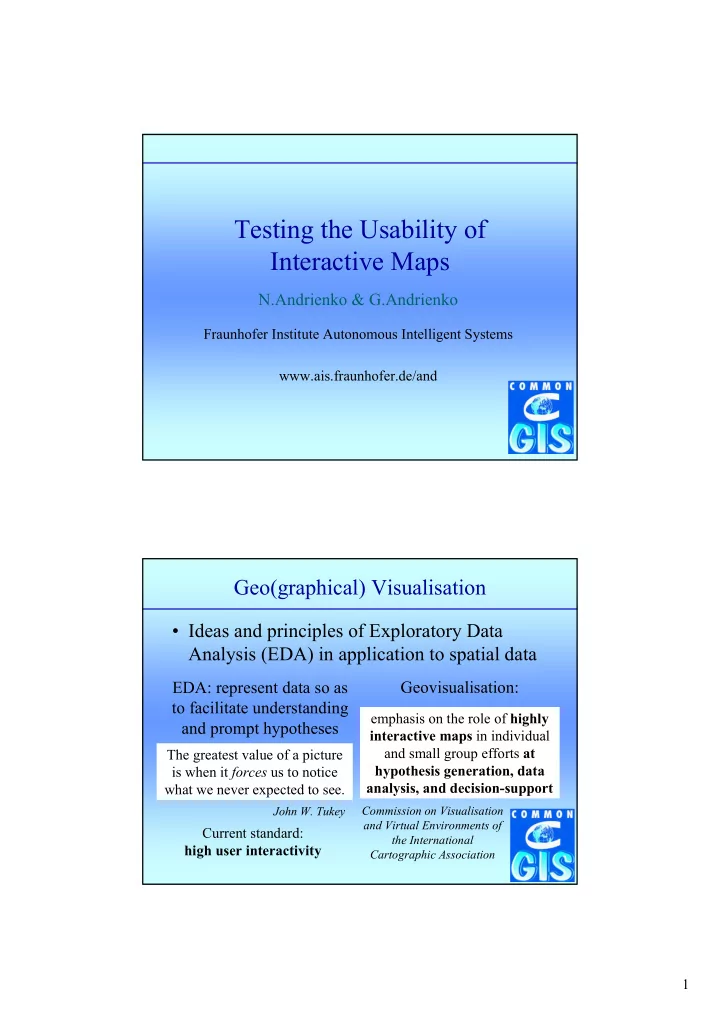

Testing the Usability of Interactive Maps N.Andrienko & G.Andrienko Fraunhofer Institute Autonomous Intelligent Systems www.ais.fraunhofer.de/and Geo(graphical) Visualisation • Ideas and principles of Exploratory Data Analysis (EDA) in application to spatial data EDA: represent data so as Geovisualisation: to facilitate understanding emphasis on the role of highly and prompt hypotheses interactive maps in individual and small group efforts at The greatest value of a picture hypothesis generation, data is when it forces us to notice analysis, and decision-support what we never expected to see. John W. Tukey Commission on Visualisation and Virtual Environments of Current standard: the International high user interactivity Cartographic Association 1
CommonGIS: System for Geovisualisation • Interactive, dynamically changeable maps – Interactive operations designed specially for supporting analysis • Interactive non-geographical displays – All displays are dynamically linked • Tools for querying, search, and classification • Computation-enhanced visual techniques All the tools comply with the current standard of high user interactivity BUT… Research question Are people able to do exploratory data analysis using interactive maps (and other geovisualisation tools)? Problem: not only the tools are new but the ideas ; no analogues exist in user’s usual experience ⇓ Not only the UI needs to be learned but (first of all!) the ideas understood 2
Organisation of Usability Tests • 1 st round (Lisbon, Portugal): 9 participants - professional users of GI, programmers, managers. – Introductory demo about 30 minutes, then the test (57 tasks, 71 questions). Test language: Portuguese. • 2 nd round (Lisbon, 1 month later): 6 of 9 participants of the 1 st round. – No access to the system between the tests. Shorter test (38 tasks, 44 questions). Test language: Portuguese. • 3 rd round (WWW-based): 102 complete test records from students of Univ. Darmstadt (11 persons, computer science) and Univ. Muenster (91 persons, geoinformatics). – Written illustrated instructions. 38 tasks, 44 questions (same as in 2 nd round). Test language: English. Interactive Techniques Tested • Focusing (outlier removal) • Visual comparison • Dynamic classification • Dynamic query • Dynamic linking of heterogeneous displays (map and scatter plot) See a demo… 3
Test Tasks and Questions (Examples) Test Results; Rounds 1 and 2 Round 1 ☺ Users were able to understand the ideas and master the tools Round 2 ☺ Users could maintain the skills and re-apply them after a recess 4
Test Results; Rounds 1 and 3 Round 1 Round 3 � Without a demo the results are much poorer 3 rd Round Results: Percentiles ☺ These two techniques seem to have been easier to understand 5
3 rd Round: Use of Explanations Mean time Number of participants spent Unit viewing the Viewed for Viewed for Viewed for Not explanations less than 1 1 to below 2 min and opened (sec) min 2 min more Outlier removal 112 23 25 24 30 Visual 143 12 18 23 49 comparison Dynamic 101 14 25 22 41 classification Dynamic query 85 16 36 18 32 Dynamic 117 15 31 17 39 linking Research question Are people able to do exploratory data analysis using interactive maps (and other geovisualisation tools)? Problem: not only the tools are new but the ideas ; no analogues exist in user’s usual experience ⇓ Not only the UI needs to be learned but (first of all!) the ideas understood 6
Conclusions • After a demo, users are able to understand and use geovisualisation tools • Written instructions cannot adequately substitute a demo – Research challenge: how to instruct users and introduce new ideas when demo is impossible (e.g. tools in WWW) • Communication in users’ native language is important Proceedings: Vol. 2, pp. 1153-1157 Present Time and Future • More interactive tools appeared in CommonGIS, e.g. tools for spatio-temporal analysis, multi- criteria decision support, etc. ⇒ More tests are needed • We seek partners for conducting new tests • We seek tool users for getting feedback • We seek support from industry for integrating our tools with widely used software www.ais.fraunhofer.de/and www.CommonGIS.de 7
Recommend
More recommend